I was going through the various articles here and saw that it has been a year since I undertook this little experiment in self-expression, writing on deadline, and delving deep into the strangeness that has been part of my nature since as long as I remember.
I didn’t actually get going until April, though, so it seems I missed anything about the Spring Equinox that would have been on the 20th of last March. The equinoxes and solstices are the hinges the year turns on, and their significance goes back to our earliest cultures. Marvels like Stonehenge, and many older megalithic sites, are tied to the recording of these astronomical events.
The Autumnal Equinox I wrote about last September, and, to be honest, it’s my favorite. As a self-proclaimed Creature of the Winter Dark, the coming of spring never really rallies me. I prefer the bleak-skied, dreary and damp short days between that fall between the Sun’s entrance into Libra and his later exit from Pisces which will come in a few days.
There are several springtime observances that coincide or orbit near the Vernal Equinox. For example, on the 17th of the month, Irish Catholics observe St. Patrick’s Day. Patrick, like Brigid, is more myth than man. Wherever one finds the Irish diaspora, this day is celebrated, frequently with drunken revelry, and a good many “temporary” Irish folk.
My ancestors hail from eastward across the Irish Sea in what is now called Wales. Along with the Scots we share some commonalities with those Irish folk, in that our original religion and culture was altered by the coming of Christianity. There are a number of memes out there about how the “snakes” Patrick is supposed to have driven out were the pagan culture, and they usually affirm that the pagan culture is coming back. I would counter that the pagan culture was less driven out, as merged into, that distinctive flavor of Catholic practice that is unique to Ireland and her people.
We tend to see the spread of Christianity through early pagan peoples as being of the same character as that imposed on indigenous peoples in the New World by a church fueled by the Holy Inquisition. Ireland’s conversion came at a time that the Catholic faith was growing outward from Rome, but was by no means dominant. Converts in this period were frequently politically and/or financially motivated. As noted in my post about stolen holidays from last fall, trading with Christian neighbors provided an impetus to conversion, and conversion of the chieftains and nobles meant conversion of the people.
I’m fairly sure that later characterizations of Patrick’s miraculous success in Ireland are retroactive continuity, embellished by a church that had moved into the driver’s seat in European geopolitics, and could say “without fear of contradiction” what they wanted to about the conversion of the Irish.
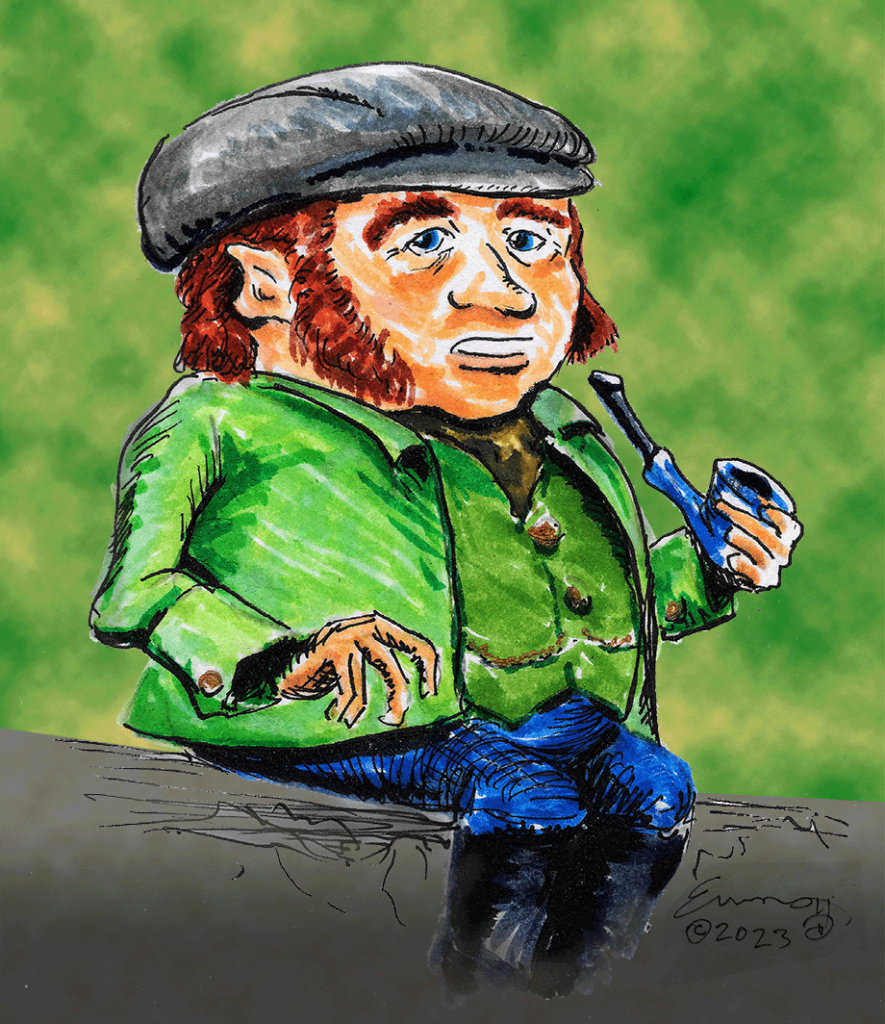
In March, I took the comet prop and recreated it as a leprechaun for the St. Patty’s party. When finished, someone in the group christened him Vernal Equinox (Vern for short) and he operated as something of a mascot for a few years, before I think I eventually gave him to one of the other members.
In the era before everyone had a satellite linked broadcast TV studio in their pocket, photographs were fewer and further between, and I have been unable to find a picture of Vernal. This drawing made from memory is perhaps more flattering than the styrofoam, hot glue, latex and green fabric he was made of, but it’s a fair resemblance. I include him as evidence that my penchant for creating unusual creatures goes way back.
Which is why it is so absolutely delicious that much of what we see in the average St. Patrick’s Day festivities, are the remainders of the preceding Celtic faith…that of the leprechaun.
Leprechauns are the Irish version of the gnome and the kobold. They are a species of faerie that is widespread in the folklore of most of Europe. The “little people” are the inspiration for Tolkien’s hobbits, but as a branch of the Tuatha de Danann they represent a much broader tradition.
The people of Danu were, according to legend, the third race that inhabited the island before it was settled by the Celtic people coming from mainland Europe. Before the Danann there were a race of giants, called the Fomorians, who may have been personifications of a raw chaotic nature. When we reference beings like the Dagda, the Morrigan, Lugh and Llyr, were are remembering this ancient people.
The faerie faith that remained up into the early twentieth century in remote parts of Wales, living side by side with modern Christianity, was the remains of that ancient relationship with the Children of Don. These beings were said to inhabit specific places, like mounds and earthworks, passage tombs, some natural places like Scotland’s Faerie Glen, but most often they lived under the hills, or within them.
They transversed into our world through clefts in the ground, cave openings, water crossings, and other liminal spaces, altering size and shape as required. Their hidden kingdom was timeless, and filled with riches and splendor. Mortals lucky (or unlucky) enough to be “taken by the faeries” might expect to spend a few hours in such places, only to have years pass in the outside world. Gold and silver from the twilit realm turned to stones or acorns when removed, or when the morning came. And we all, of course, know that the dancing faerie court turns into the circle of mushrooms at dawn’s first light.
The presence of such beings was a reality to most inhabitants of Ireland and the western and northern parts of Britain in the 19th century. Various means of protecting oneself from these beings are recorded by anthropologists and mythologists. While not necessarily malevolent (or at least not so as a species) they were viewed as sufficiently different from humans as to be considered dangerous. This is perhaps the same way we might regard a lion or a tiger. The lion and the tiger don’t decide to be harmful, but their nature makes them potentially harmful.
Of particular importance was not offending the Bright Folk. They were an ancient nobility, and as such demanded a particular etiquette. If one encountered a faerie on the road, in the woods, or at their door, they were to be treated with the utmost respect. There were protocols, many involving not giving the being your actual name, but rather offering an oblique pseudonym by the method of saying “you may call me…” To refuse giving the name would be rude, but giving your true name would put you in great peril. Of course, it was expected that the faerie was not giving their real name either, so everyone played the game.
Iron was considered especially upsetting. There is some question as to whether it was specifically meteoric iron that the Fae found so distasteful. But over time iron and steel that included it was considered a way of preventing unwanted visits from the Good Neighbors. Iron or steel pins were often fastened to the swaddling of babies, to prevent their being stolen and replaced by changelings.
This business of spirit warfare is still ongoing. The iron “lucky horseshoe” is derived of this tradition, though most who hang them over their thresholds probably don’t know they are trying to keep out errant fae folk, gnomes, kobolds, leprechauns, and a host of other beings who are inimical to the presence of ferrous metal.
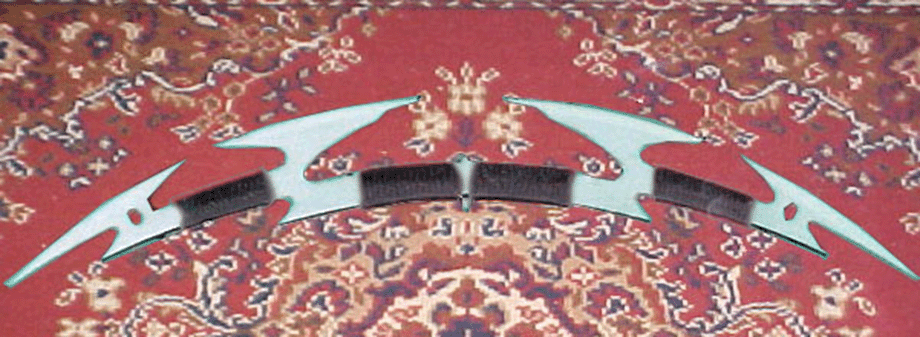
I personally have not found the numerous swords and blades in my house to keep away my friends among the Bright Ones. I suppose that the fact they are invited may abrogate any such taboos. It never comes up in discussion (that would be gauche) and I have known many of them longer than I have known about the iron thing. Of course, if it turns out that meteoric iron is the key, then I only have a few pieces and they’re small.
I try not make my space difficult for spirits. I don’t for example, practice the same kinds of cleansing rituals I see discussed all over the interwebs. These practices, very often employing white sage and/or palo santo, which are both being impacted by the increased demand, are not something I learned when I first started working in the occult. In fact, my first awareness of it was in a fiction book maybe about a decade ago, where it was cast as an indigenous practice, used in response to a malevolent spirit.
By definition, the practice of cleansing is to drive off such spirits, entities, and energies to protect the home and the persons in it. I take a somewhat different approach, one that has served me well for many years, and that is to deal with my spiritual and ritual space the same way that I deal with physical space it occupies. And, well, I really just hate to do house cleaning.
Now, I do actually do house cleaning. I have several cats and there are some basic things that you just have to do for the sake of hygiene. Likewise, my kitchen gets policed after every meal, and on weekends, when I have time, I’ll attend to anything that takes a bit longer, or has gotten behind. But chances are, you’ll find dust has accumulated on some lesser-used surfaces, and there might be a cobweb or two in some of the corners. I’ll remove the dust from time to time, before it does any significant damage to the furnishings or other items. As for the cobwebs, the spiders do a good job of limiting other household pests, so there’s something of a detente there. Also, I like spiders. Otherwise, I generally spend my time on other more productive or enjoyable processes, and try to minimize the amount of cleaning I have to do by not tracking in dirt.
How does this method apply to the spiritual space. Well, let’s take that point by point.
In the sense of the things that have to be done, I start with warding the property in general. This applies to unwanted spirits, criminals, and traveling salespersons. If you aren’t invited to my house, you are not welcome. A coworker of mine once helped me move some heavy furniture to our upstairs bedroom. He remarked that he would pity anyone who tried to break in, because there is virtually no place in my house that I can’t just reach out and have a weapon. Those are the visible ones. And several of them have enchantments. These charged objects and symbols perform the functions of locks.
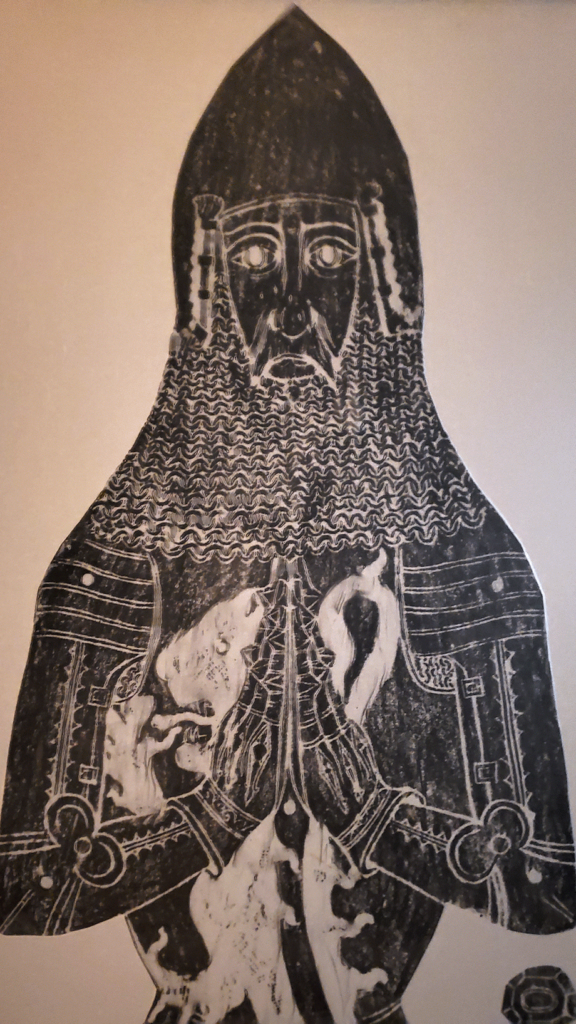
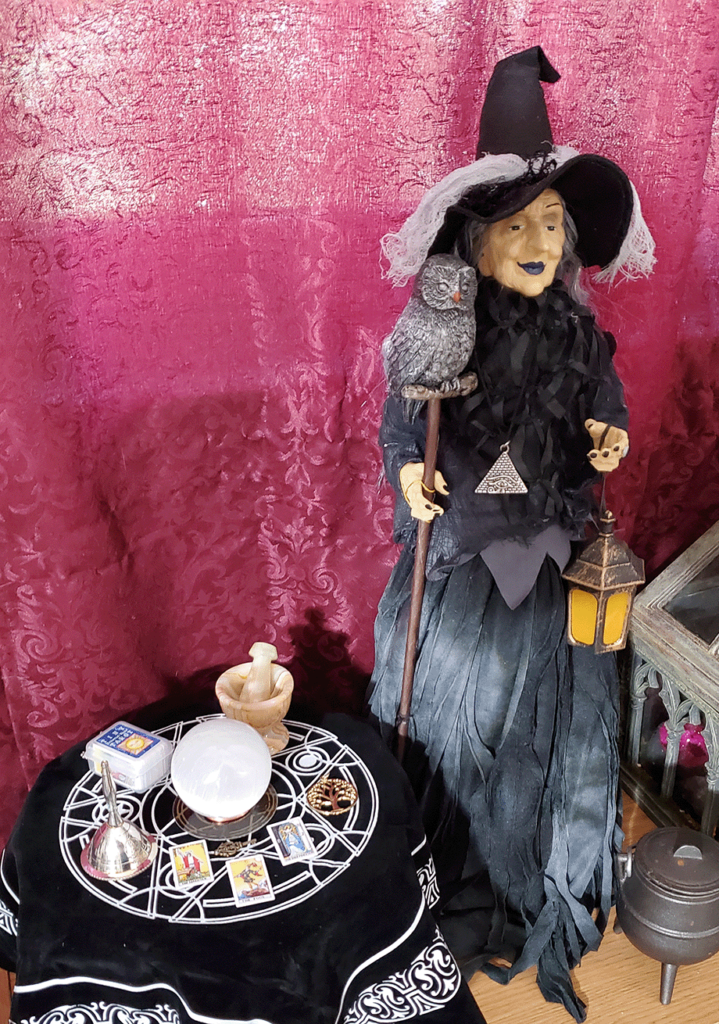
Like any house with a watch dog, I have certain friendly spirits that reside with me, and/or travel with me, that provide protective or surveillance functionality. In combination with wards and sigils, they work to reduce the potential that something crosses my threshold without my awareness or invitation. These are a constant and ongoing defense, and require regular maintenance just like doing the dishes and emptying the cat box.
The second key factor is to clean up things when they happen. If there is a breech, I will deal with the problem and seal it back up. This is analogous to cleaning up a spilled drink (or cat vomit in my world) as soon as it happens, so there’s no permanent stain in the rug. Sometimes that is as simple as mopping up the mess, and sometimes it’s the spiritual equivalent of getting out the carpet shampooer. The response is dictated by the severity of the issue. Sometimes it just needs a damp paper towel. Sometimes I have to get out the Black Book.
And finally, I don’t track dirt into my house. At least I try not to do it. I’ve been at this for over half a century, and I have done some stupid things in my time. I have been lucky enough to learn from it. As Dean Martin is supposed to have said, “Good judgment comes from experience, and experience comes from bad judgment”. Before undertaking any significant spiritual working, I make a risk reward evaluation, and do what I can to mitigate the risk. Sometimes, the benefits simply are not worth it to me. Your mileage may vary.
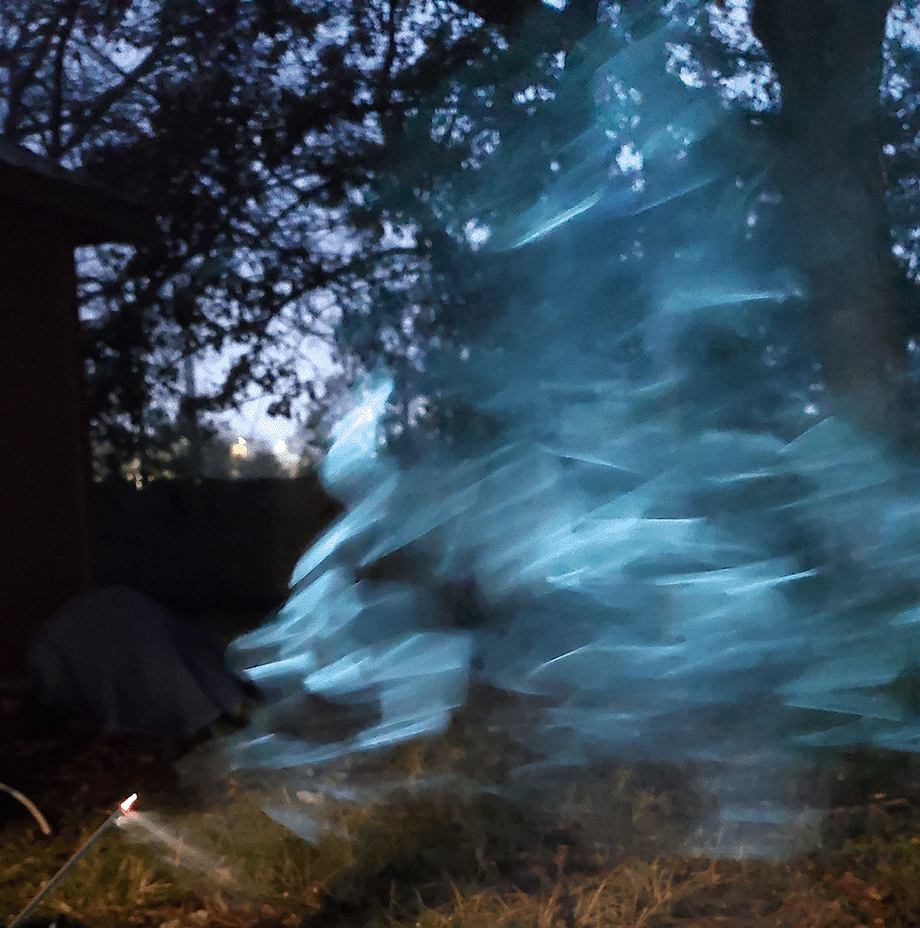
Demons, imps, djinn, and other spirits of a more chaotic nature have been employed throughout history as guardians and gatekeepers.
Hades took the three headed dog Kerberos as protector of his underworld realm, preventing those inside from leaving, but also keeping out the unwanted. In some tales he is said to eat those trying to escape. I wonder if Kerberos is a Graeco-Roman confusion of the Egyptian psychopomp Anubis (Anpu in Kemit) in his form of the black dog, and the Ammit, the devourer of the hearts of the unworthy at the balance Anubis manned.
I burn incense as a gift to the Fae, On occasion I will find forms in the smoke, like the big fellow here. Whether he is visiting them, or just hanging around on the porch, he’s no concern to me, and I am sure that nothing is getting past him.
If you visit me on any given day, there will probably be incense burning. I like incense. It minimizes foul odors (see cats, above), relieves tension, drives off pests like mosquitoes and flies, and smells nice. This is most probably why the ancients starting using incense. In the cradles of civilization, usually along rivers, lakes, or seashores, insect-borne diseases were a real problem. Burning the resin of a shrub caused a drop in the number of mosquito bites, and consequently a drop in cases of malaria, yellow fever, and other similar diseases. The ancients may or may not have made the initial connection to it’s use as a bug repellant, but eventually the power of incense to dispel and drive out spiritual “bugs” was ascribed.
Incense as used to create or purify ritual space is widespread in many practices, both occult and orthodox. I am keenly aware of this functionality when I burn incense, though I don’t always have that intention when I burn incense. On the other hand, my incense burners all have some sort of magical inscriptions or ritual configuration, in which case they are “always on”, whether I am creating a ritual space for spell work, or just in the studio painting, writing, or composing.
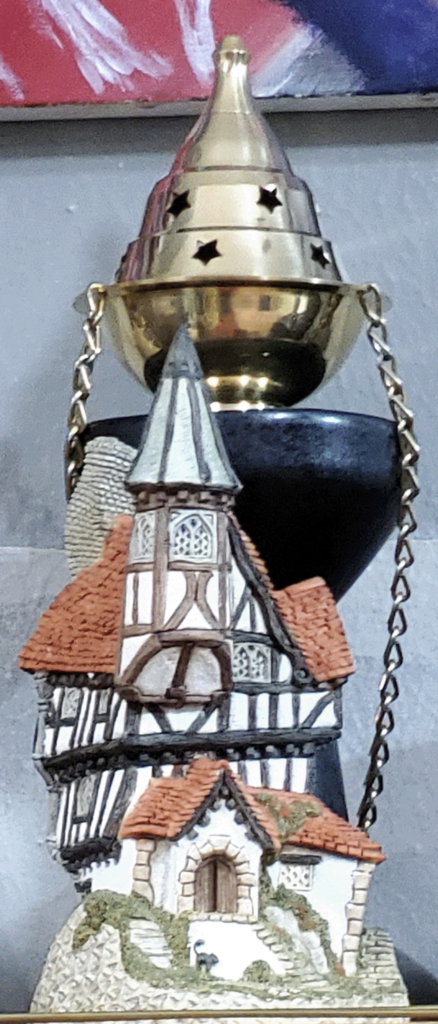
Many things in my house have enchantments associated with them. I create sacred space around me that is always protected. While it may need energizing from time to time, I haven’t found that a constant focus on ritual cleansing is necessary.
But if that works for you, more power to you. Literally. The practice of cleansing rituals, provided they are combined with rites to bring in positive and beneficial entities and energies, will help reinforce your own spiritual refuge; whether you see it as quirky old house or an impenetrable castle. I have versions of both.
This is a layer of passive protection that permeates my space. But I don’t generally go and light it up and do a cleansing ritual. Cleansings as I see them described often seem an awful lot like exorcism. When used to drive out a malevolent entity, they clearly are an exorcism ritual, and my particular concern is that may not be something we want to be doing every week or day or whatever in our personal space.
Jason Miller in his Consorting With Spirits and on numerous podcasts, has cautioned against this for the simple reason that you are potentially making it difficult for any spirits to enter your personal space.
In the wake of the pandemic, we all have perhaps become a bit more intense in cleaning our home environments. While we concentrate on removing the harmful pathogens, we use methods that destroy beneficial bacteria. The same can be said for spiritual cleansing.
I remember reading many years ago in one of Sybil Leek’s books (don’t recall which, probably Diary of A Witch) that the key to such things was balance. If we do something extreme in one direction, we must do other things to balance that out. If you feel safer by doing a cleansing ritual each day, by all means do so. But follow it with a ritual that invites back in your friendly spirits, patron deities, and positive energy.
I’ll close with that thought. Next week’s article will be an introduction to the summer’s project for me, an exploration of the Major Arcana in depth. I intend to take a card each week until late August, though I expect I may have some additional articles pop up as the muse strikes. I hope you will join me.

